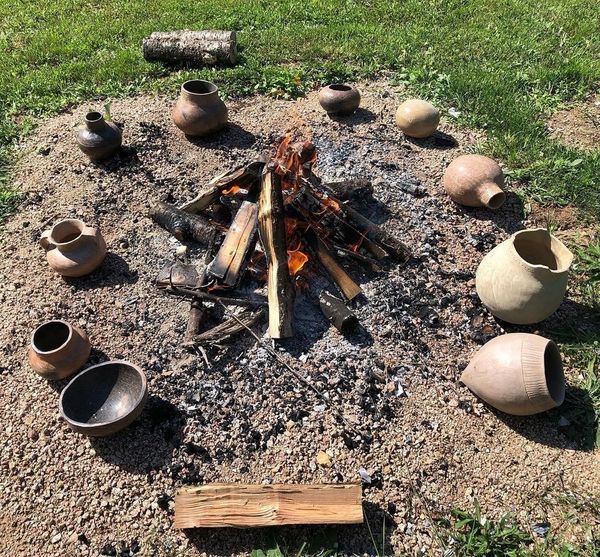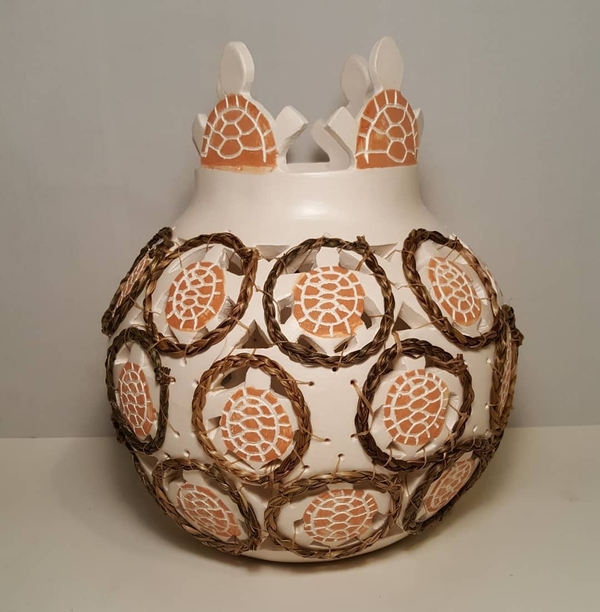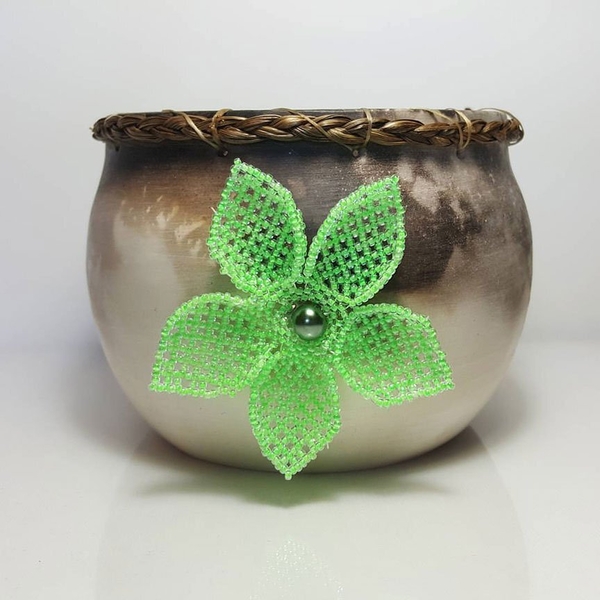
Weaving Stories in Clay: The artistic odyssey of Nancy Oakley
Supported by the Creating, Knowing and Sharing program
In the heart of Eskasoni, where the whispers of ancestors blend with the song of the wind, Nancy Oakley moulds her stories into clay. Her hands, steeped in tradition and love, sculpt vessels that are more than art—they are pieces of her soul, echoes of her heritage and voices from the past.
For Nancy, her Mi’kmaq and Wampanoag heritage doesn’t just influence her artwork, it is her artwork. The lines between her, her art and her culture blur into one cohesive identity.
“It is hard to differentiate between me, my artwork and my culture, because it is all a part of who I am.”
— Nancy Oakley
Immersed in the traditions of powwows, ceremonies and traditional art, her creations are a vivid tapestry of her cultural experiences. Weaving myth and story into art, Nancy continues to find ways to incorporate stories and lessons into her pieces.
A deeply personal art form

Photographer(s): Nancy Oakley
Nancy’s journey began with a camera in her hand at the Institute of American Indian Arts (IAIA), while she was majoring in photography. During her final semester, she enrolled in a traditional pottery course, where she learned to make her own pottery and fire it traditionally. This experience left a lasting impression on her. However, after graduating and moving back east to Eskasoni, her passion for photography waned when her camera broke just as digital photography became popular, making her lose interest in the craft she once loved for its darkroom processes.
Back in Eskasoni, Nancy began working at her aunt and uncle’s basket shop, rediscovering a love for black ash basketry and beadwork, skills she had learned from her mother as a child. Later, at the Nova Scotia School of Art, she explored various art forms, including ceramics, jewellery making, photography and textile weaving. Although the demands of motherhood caused her to leave during her second year, her passion for pottery continued to grow. Inspired by her upbringing and the desire to integrate parts of her culture with her work, she began incorporating elements from all her other artistic pursuits into her ceramics. Nancy began trimming pots with sweetgrass like in basketry and adding hieroglyphic prayers. Over the years, her pottery evolved, blending these diverse influences into a unique and deeply personal art form.
The language of natural elements

Photographer(s): Nancy Oakley
Years later, Nancy discovered that she had clay in her own backyard, rekindling her love for pottery after a lull. Using guidance from YouTube and mentorship from Indigenous clay artists like Richard Zane Smith, Nancy began honing her craft and harvesting her own clay. A notable creation from her newfound harvesting practice was a piece she created for the Kiknu care centre in Eskasoni using clay she gathered at the building site. The piece symbolizes the bridge between the past and the present and a tangible connection to the land and its stories.
In her pottery, the natural elements speak their own language. Fir tips, which are used in smoke firing, leave dark, mysterious-looking traces on the clay. Seaweed, gathered from the shoreline, imparts delicate hues of pink. With her children, Nancy collects and harvests mussel shells for tempering clay and collecting sweetgrass, ensuring that these traditions are passed on to the next generation.
Occasionally weaving myths and stories into art, Nancy ensures that her work also embodies a rich mythological narrative. In her piece Sacrifice (06nitapesk), Nancy delves into the flood stories that created Turtle Island, stories of a time when animals swam in floodwaters, each diving down in a desperate attempt to find some earth. Many failed, but eventually, a muskrat emerged with a piece of earth and placed it on the back of a turtle shell, creating Turtle Island. Embedded into Nancy’s piece is a timeless tale of the creation of a new world while illustrating the profound theme of maternal sacrifice.
Motherhood: The heartbeat of her art
Motherhood is the heartbeat of Nancy’s art. Her children, woven into every journey and creation, are as much a part of her work as the clay itself. Her family travels to shows and powwows across Canada and helps Nancy harvest materials for her art, which is sold at shows, and even plays a role in the creation of her pieces.

Photographer(s): Nancy Oakley
“We travelled to powwows. They learned traditional dancing, how to pick sweetgrass, beadwork, pottery, gardening, how to tap maple trees. We even used one of my traditional cooking pots to cook the maple water into syrup.”
From their mother, the children learned traditional crafts, the art of self-sufficiency and the beauty of their heritage. “I hope I showed them how to be self-sufficient, how to love themselves and their families, and not to be afraid to go for their dreams," she says with pride. The traditions she instilled in them continue to flourish, a living legacy of her dedication and love.
Nancy Oakley’s pottery is more than art—it is a living narrative, a blend of earth and spirit, tradition, and innovation. Through her hands, the stories of her ancestors find form, ensuring that their voices continue to resonate through the clay, inspiring generations to come.


